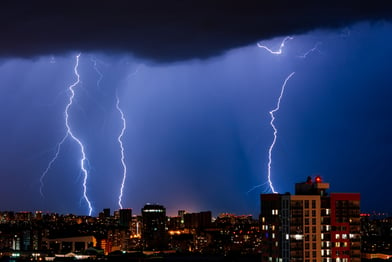
Summer is here, and in many places, summer can mean severe weather and thunderstorms. With thunderstorms of course comes lightning.
Most people know to go inside when there’s lightning to avoid getting struck – but what about your home or business building? Electricity from events such as lightning strikes is the of home fires each year in the United States.
The first step to prevention is understanding lightning strikes. In this blog, we’ll walk you through what happens when lightning strikes and what you can do about it.
What Happens When Lightning Strikes Your Home or Business
If lightning strikes your home or business, the sound can be overwhelming. The building may shake, and shock waves from the sound can be intense enough to cause structural damage. For example, a lightning strike could topple or destabilize brick or stone chimneys, or even jeopardize the main structure of the house itself.
Lightning strikes want to travel to the ground, and they’ll travel through your home to get there. This means that lightning will travel from the strike source through electrical wires, causing an explosive surge that can destroy all of the wires and even gas piping. A lightning strike will likely damage or destroy any electronics that are plugged in and can also cause gas leaks due to pipe damage.
But the biggest risk when lightning strikes a building is the risk of fire. Not only is fire extremely likely, but it’s also almost guaranteed due to the amount of electricity that’s discharged in a lightning strike.
If you’re in a building or home that’s struck by lightning, immediately call the fire department, even if you can’t see or smell smoke. Firefighters have special equipment to detect heat signatures that can expose any fire that might exist.
Preventing Lightning Strikes
After realizing all of the damage that lightning can do, you probably want to prevent lightning from happening. But in reality, you can’t prevent lightning strikes. You can, however, guide them.
Lightning rods can be attached to the roofs of buildings or homes, and they serve as a way to guide lightning into the ground in a way that poses much less risk of fire and destruction to a building and the electronics inside it. A complete lightning protection system would include electrical surge protectors, protection for gas piping, and a bonded path for lightning to travel from the rod to the ground, bypassing the electrical system of the building. Generally, the rod connects to a huge piece of aluminum or copper wire, which in turn is attached to a conducive grid that is buried in the ground somewhere nearby.
According to a study from Underwriter Laboratories, a properly installed lightning protection system can be up to 99% effective in preventing damage from lightning. Any lightning protection system should be done professionally by an organization that’s recognized by the Lightning Protection Institute, National Fire Protection Association and Underwriter Laboratories.
However, whole-house or whole-building protection can be very expensive, and sometimes prohibitively so. A free precaution to protect your possessions can be simply unplugging any valuable electronics when you know a thunderstorm is approaching, including any appliances.
And, don’t forget protecting yourself! During a storm, stay inside if possible. If outside, be sure to wear shoes, as lightning can travel across soil, pavement, and any wet surface. Stay away from wires and pipes and don’t lean on any metal windows in case the building you’re in is struck.
It’s also advised to not use running water – such as doing dishes or taking a shower – because if your home is struck by lightning, electricity can also travel through the water in the house.
What to Do When Lightning Strikes
Sometimes, no matter what preventative measures you’ve taken, a building is just going to get struck. If this happens to you, there are some simple steps to follow:
- Make sure everyone is okay. Before you do anything else, track down all of your family members or check-in with your employees to make sure no one is injured. If there are injuries, it's important to remember any first aid training.
- Check for fire or smoke. If you see fire and smell smoke, everyone needs to evacuate immediately. The risk of staying inside of a building that’s on fire is greater than the risk of going out in a storm.
- Call 911. Even if you don’t suspect fire, call the fire department. With lightning, fire can start in tough-to-see places that firefighters are equipped to find and handle.
- Check for damage. Check your house for damage to the roof or wherever the lightning struck. Check the outlets also for signs of fire or burning.
- Call your insurance agency. Once emergency responders have arrived and everyone is in a safe location, call your insurance carrier to figure out the claims process.
- Call a trustworthy electrician to inspect the wiring. If the house is not destroyed, the final step is to call an electrician to make sure all of the wiring is still functioning properly. This can help prevent fires or other dangers down the road.
Fire Prevention and Detection
The idea of a lightning strike can be scary – but if you know what you can do to prevent it and what to do if it happens, you’re as prepared as you can be.
If you’re a business owner, a preferred fire and life safety company can help provide protection should a lightning-induced fire occur. With a wide range of sprinkler systems, alarm systems, extinguishers and more, skilled professionals will work with you to build a custom plan to keep your people and your product safe.

